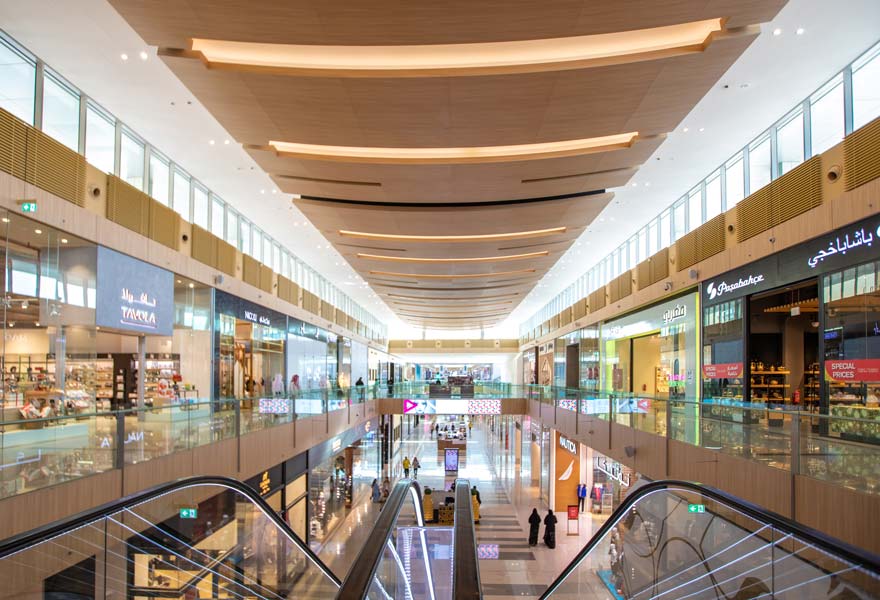Ashghal has opened the second 537-meter flyover bridge at Umm Lekhba (Landmark) Interchange, providing free-flow traffic from Al Markhiya towards Doha as part of Sabah Al Ahmad Corridor project.
The new flyover consists of two unidirectional lanes from Al Markhiya to Doha and will accommodate around 4,000 vehicles per hour.
Road users coming from Al Markhiya Street towards Doha can pass through the new flyover without diversions, which will ease the pressure on Immigration Intersection, offering a parallel route to Khalifa Street towards Doha.
The flyover serves the residents of Duhail, Madinat Khalifa, Al Markhiya and road users coming from Al Corniche and heading for Doha and Al Gharrafa via 22 February Street.

Source: Peninsula Qatar
It also offers an alternative route for road users coming from commercial facilities, complexes and many educational and health institutions in addition to those coming from Qatar University.
The opening of this bridge comes two months after the opening of the 820m first flyover bridge of Umm Lekhba, which extends from the new Al Hateem Street to 22 February Street, the two flyovers cross 22 February Street to form three lanes, which will contribute to free flow of traffic towards 22 February Street and Doha south.
Ashghal said that 65% of the Umm Lekhba interchange development, known as Landmark Interchange, has been completed and remaining construction of this huge and vital interchange is underway around the clock.
Once completed in the last quarter of 2020, the new interchange will significantly improve traffic to shorten the journey time by more than 70%. The bridges provide nine arteries that provide a free traffic flow in nine directions in addition to the free traffic on Al Shamal road as well as the underpass of the old interchange linking Al Markhiya Street and Sabah Al Ahmad Corridor.
Largest Interchange
Umm Lekhba interchange is the largest interchange in Qatar with a length of 11 kilometers. It consists of four levels and is the first in Qatar and contains nine bridges that provide free traffic flow in all directions.
The interchange accommodates more than 20,000 vehicles per hour. Five bridges consist of two lanes in one direction, while the other four bridges include one lane in one direction.
The interchange is the second highest interchange in Qatar after the interchange of Umm Bishr on the G-Ring Road, which is at an altitude of 35 meters while the height of the highest bridge reaches 36 meters.

Source: Peninsula Qatar
North Gate Interchange of Doha
Umm Lekhba Interchange is considered to be the northern gate of Doha and a “distribution station” due to its strategic location. The interchange is located at the northern gate of Doha, where heavy traffic to and from Doha via Al Shamal, it is located in an important spot where Al Shamal Road intersects with the Doha Expressway, Al Markhiya Street and Sabah Al Ahmad Corridor.
Above all, the interchange is located in a densely populated area and a vibrant commercial activity where there are many government entities, educational and health facilities as well as complexes and commercial markets.
The interchange will ease the pressure on Doha Expressway, especially at the Al Gharrafa interchange known as Immigration and Al Duhail intersections. It will also achieve a great traffic flow in front of those coming from Doha Corniche, Markhiya, Madinat Khalifa and Duhail in the direction of Al Shamal Road, Sabah Al Ahmad Corridor, Al Gharrafa and Gharrafat Al Rayyan areas to Al Luqta and Al Rayyan.
Sabah Al Ahmad Corridor extends for approximately 25 kilometres from Hamad International Airport to Umm Lekhba Interchange (known as Landmark Interchange) on Doha Expressway. Its scope includes the upgrade of seven main roads namely, E Ring, F Ring, Mesaimeer, Al Bustan, Bu Erayyen, Lebday and sections of Al Markhiya Street. In addition, Ashghal will enhance 12 kilometres of local and peripheral roads intersecting with the Corridor. The total road works of the project is approximately 37 kilometres.
“Delivering traffic relief in Doha”
Once completed in 2021, Sabah Al Ahmad Corridor will significantly contribute to the relief of traffic congestion on Doha Expressway in particular, 22 February Street. The new Corridor will be a vital alternative and parallel route that will serve thousands of daily commuters from the north to the south of Doha.
Commuters travelling from Hamad International Airport will be able to reach Umm Lekhba Interchange in approximately 18 minutes compared to the current 50 minutes via Doha Expressway and 22 February Street reducing traffic time by 70%.
The new Corridor will also form a vital link between the north and the south through Doha, which will constitute a key point to accommodate traffic of Doha Expressway to the southern part of Doha (Al Wakra Bypass) linking Mesaieed through Al Watiyyat Interchange, at F Ring Road, which will constitute a key point to accommodate traffic to both Sabah Al Ahmad Corridor and Doha Expressway.
This significant improvement in traffic will occur due to increased road capacity to more than 20,000 vehicles per hour in both directions after the expansion of the corridor, which will be upgraded to four and five lanes in each direction instead of three lanes, Doha Expressway currently accommodates 12,000 vehicles per hour in both directions.
More on News & Updates






Leave A Comment
You must be logged in to post a comment.